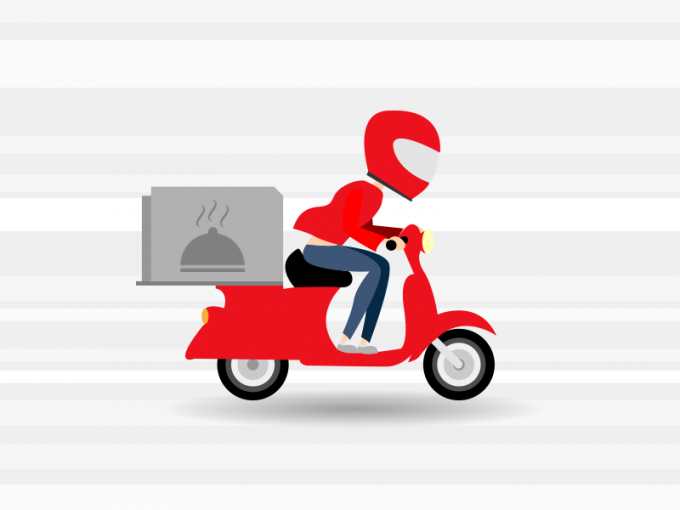<

People are increasingly opting to eat takeaways at home instead of dining out, and many restaurants are adopting services such as Just Eat or Deliveroo to keep up. However, before you start offering a delivery service to your customers, you need to carefully consider whether it’s right for your restaurant.
Partner or go it alone?
There’s nothing new about takeaways, but the rise of online ordering has helped drive rapid growth, the main reason behind this growth is its win-win proposition. Customers get access to quality food they couldn’t get delivered before, restaurants increase their revenues and hundreds of drivers generate new income. So, what are the best delivery options? Most small operations outsource to a partner, and the real pioneer of that business model was Just Eat. Operating in a similar way is Deliveroo, however Deliveroo targets well established restaurants opposed to the traditional takeaways like kebabs and pizza. Existing Deliveroo partners include Wagamamas, GBK, MEATliquor, and even the Michelin-starred Indian restaurant Trishna. Another option is UberEATS who is currently partnered with over 2,000 restaurants in the UK, including Leon, Chilango, Ping Pong and Itsu. The main selling point for these three partners is their ability to replace the antique phone-ordering system with an optimised web and mobile platform, which can then integrate with their kitchen workflow.
Cost
Are these delivery platforms really a worthy investment? It’s vital to look at how these different platforms will help grow your customer base, how much it will initially cost you and what you will get back in return. Just Eat partners pay a sign-up fee of £699, with the company then taking 12% of each order via their website or app. However, they do reinvest some of the commission you pay back into marketing campaigns to help your business get more orders. Deliveroo add a £2.50 charge for managing delivery and then take a percentage of the order value. The benefits of working with Deliveroo include securing new customers, removing the burden of delivery logistics and payment processes, marketing your business both offline and digitally via social media campaigns and driving demand at times of the week when restaurants are often less busy. Lastly, UberEATS collect a service fee which is calculated as a percentage of sales, however they claim that a top restaurant can earn on average just under £5,000 a month by partnering with them. They’ll help get you set up, promote your menu and work with you to improve pickup and delivery times, which is key to encouraging repeat customers. They also guarantee that their drivers will deliver your food within 12 minutes from pickup to drop off. As with the other partner options, UberEATS works with you to improve operations and promote your business.
Maintaining your image. Should you or a partner deliver?
Independent restaurants often worry that their brand won’t be properly represented by delivery partners, and this holds them back from offering the service. Any service that fails to deliver on time or with good quality food will naturally damage the brand values any restaurant has built. It’s important to think about the logistics involved and be prepared by anticipating the challenges; orders should reach your customers just as fresh as when they left your restaurant. Delivery time is one of the most important elements related to this and setting a delivery radius ensures food is both served quickly and as fresh as possible, even if the food is delivered by a partner company.
Will delivery kill restaurant trade?
This is arguably the most important factor to consider – if deliveries become too popular, will they eventually kill in-house trading? For most restaurants, deliveries do not greatly affect sit-down demand, as you are accessing a brand new audience of people – you are not targeting your regulars and trying to make them eat at home. It’s a great way of generating extra revenue from new customers that you don’t have to wait on or provide table space for. However, it’s important to achieve a balance, and ensure that your delivery offering will not disrupt regular dine in customers or the efficiency of your staff. For example, drivers should not be coming in and out of the dining room area affecting the atmosphere, and chefs must be able to handle the added demand from takeaway orders. Ultimately, you don’t want to lose restaurant trade and reputation in favour of online orders, as delivery will not replace the experience and enjoyment people get by dining in a restaurant.
Fuelling demand
You must firstly ensure there is a demand for offering delivery. A good way to start is to trial a few key dishes from your menu. UberEats launched a scaled down delivery-only menu with New York chef Michael White based out of his Ristorante Morini kitchen, this was a great way to discover which dishes were most wanted and if there were any food items that didn’t travel well. It’s a fantastic way of giving a new network of potential customers the opportunity to discover your restaurant and try your food without them having to travel. Offering a scaled down version of your menu will allow you to assess how much demand there is for your food, and gather feedback on quality without committing to a full fleet of drivers and the pressure of trying to deliver your entire menu. By gradually adding in a few specials and building your offering in line with demand you will be able to work out whether a delivery partnership is a worthwhile investment or not.
Final thoughts
Meal planning and cooking are considered chores by a good chunk of the population, so any service which offers them a relief from them is naturally going to be in demand. Delivery is now becoming an essential part of restaurant business that works by exploiting people’s impatience, and by offering an easy option for the people who want to eat ‘right now’. By taking into consideration the points above, its possible for restaurants to offer a great experience for guests who dine in as well as gain additional profit from delivery orders, there’s no reason the two experiences can’t exist alongside each other.
To find out more about how delivery is dominating the casual dining sector, don’t miss Ashley Sheppard and Tom Weaver’s speech at Restaurant Tech Live on Tuesday the 26th of September in the Keynote Hall. For more information or to register for free tickets click here.
